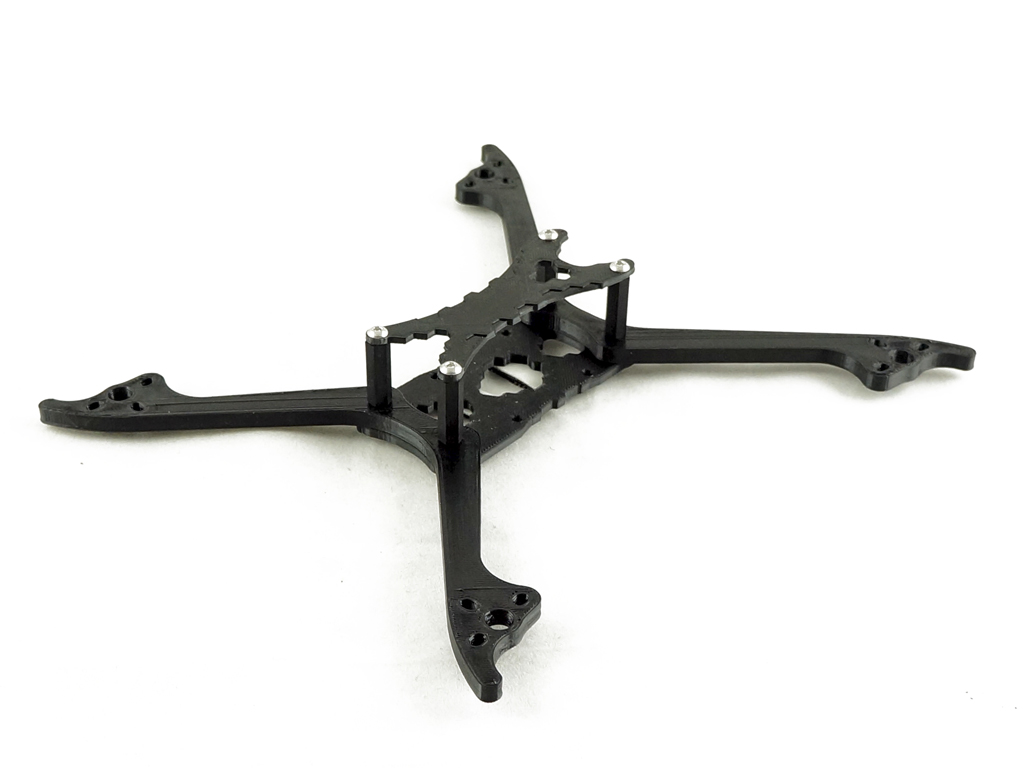“The printed frame gives us a clear picture of how the frame will look like. It’s all clear and more graspable than on a computer model. The main advantage of 3D printing is the cheap production of unit pieces. The parts, that we print, change very often. Because we print everything ourselves, we can have the necessary piece in hand in just a few hours.” Jiří Fiedler, Rotorama
Rotorama is producer of FPV racing drones. These drones are about 25 cm in size, weighing around 500 g and can fly at speed of up to 160 km per hour. 3D printing is here used for printing accessories such as camera holders, antenna holders or drones’ fins. In some cases, the propeller protectors or even a whole shed are printed as well.
Fillamentum, a producer of high-quality filaments, offers solutions for flexible production and fast prototyping with an emphasis on high utility properties that predetermine professional printing. Rotorama employees use flexible materials such as Flexfill TPU for 3D printing. Each hardness, Shore 92A and 98A, is used for something a slightly different. Flexfill TPU is a highly flexible, elastic material with excellent mechanical properties. It is highly durable and has excellent adhesion between layers.

Another integral part of the drones is the frames that Rotorama designs and prints themselves. In production, prototypes are first printed in ABS Extrafill by Fillamentum and then cut out of carbon which is more expensive and the production is very difficult. “The printed frame gives us a clear picture of how the carbon frame will look like. It’s all clear and more graspable than on a computer model,” says Jiří Fiedler. The ABS material is ideal for the production of the first functional samples before mass production. It has excellent mechanical properties and it is easy to print even in detail.

The printed frame model is fitted with other components and then is tested. If the model is in order and meets the requirements, several carbon prototypes are cut and further tested, especially durability. As a standard, 1-2 universal holders are printed for the frames. Customers can print the rest themselves or on-demand.
Rotorama uses 3D printing technology mainly for flexible production and fast prototyping. Usually, up to tens of units are printed from each part. The components used for drones often differ in shape. Each antenna and camera have a different shape and each pilot requires a different camera tilt angle. Thanks to 3D printing, each part is basically tailor-made for the needs of the company or its customers. They can choose from a range of models that meets their requirements.
Rotorama models are available at Thingiverse
| Cookie | Description |
|---|---|
| _dc_gtm_UA-189275971-1 | The functionality is to store number of service requests. |
| _ga | This cookie is installed by Google Analytics. The cookie is used to calculate visitor, session, campaign data and keep track of site usage for the site's analytics report. The cookies store information anonymously and assigns a randomly generated number to identify unique visitors. |
| _ga_L703XWXLV0 | This cookie is installed by Google Analytics. |
| _gat_gtag_UA_189275971_1 | Set by Google to distinguish users. |
| _gid | Installed by Google Analytics, _gid cookie stores information on how visitors use a website, while also creating an analytics report of the website's performance. Some of the data that are collected include the number of visitors, their source, and the pages they visit anonymously. |
| CONSENT | YouTube sets this cookie via embedded youtube-videos and registers anonymous statistical data. |
| Cookie | Duration | Description |
|---|---|---|
| VISITOR_INFO1_LIVE | 5 months 27 days | A cookie set by YouTube to measure bandwidth that determines whether the user gets the new or old player interface. |
| YSC | session | YSC cookie is set by Youtube and is used to track the views of embedded videos on Youtube pages. |
| yt-remote-connected-devices | never | YouTube sets this cookie to store the video preferences of the user using embedded YouTube video. |
| yt-remote-device-id | never | YouTube sets this cookie to store the video preferences of the user using embedded YouTube video. |
| yt.innertube::nextId | never | This cookie, set by YouTube, registers a unique ID to store data on what videos from YouTube the user has seen. |
| yt.innertube::requests | never | This cookie, set by YouTube, registers a unique ID to store data on what videos from YouTube the user has seen. |